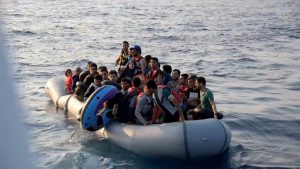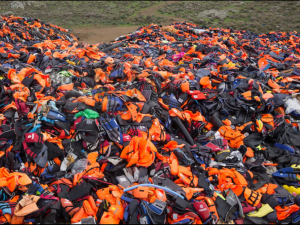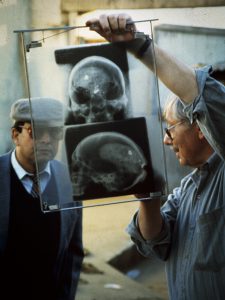Hundreds of thousands of life jackets litter the mountainside of the island of Lesvos, Greece. These life jackets are left behind by refugees who have survived the arduous journey by sea to Greece, or recovered from the bodies of those who did not survive. The sheer number of jackets is immeasurable and incomprehensible. The mountainside of Skala Skamnias is sprinkled with orange and red cheap pieces of nylon and polyester, items that are supposed to be “life savers.” According to the UNHCR, “3,400 refugees and migrants land each day” (Strickland, Patrick Al Jazeera) on the shores of Lesvos. With each refugee that lands, they shed and leave material items. Each life jacket is a story of a person who has traveled far from home and left everything behind. Like those crossing the Sonoran Desert to get to the USA, many smugglers and businesses profit off of those making the journey. One refugee was shocked “when he paid smugglers $100 only to find that his jacket was packed with nylon and padding…People spend their life savings and are only given symbolic protection” (Strickland, Patrick Al Jazeera). One can find these life jackets offer no protection. Lesvos does not have the capacity or ability to recycle the thousands of life jackets and cannot afford to ship them to mainland Greece, so they are simply sitting in what looks like a material graveyard, remnants of people’s lives tossed away.
In an unfortunately ironic twist, the conference on “Dialogues in Archaeology” was hosted in Lesvos in 2016, and the opening discussion was about “The Archaeology of Forced and Undocumented Migration” (Hamilakis, Yannis The Nation). In a country rich with remains of monuments and material culture, it is ironic how this unique and relevant material culture is not being studied or cared for. The entire country is covered in remains of boats, dingies, life jackets, shoes, clothing items and personal memories. Seemingly mundane and ordinary objects to some tell the stories of thousands who have risked everything to come to Europe. The sad reality is that, as of the moment, “these are not recognized by Greek law as archaeological artifacts, worthy of preservation” (Hamilakis, Yannis The Nation). Instead of learning more about the refugees, the government is ignoring the issue by not taking the accurate and necessary steps to preserve this history. Not only will Greece benefit by preserving yet another rich history, but the world will benefit by learning the stories behind each life jacket, shoe, and tent. This archaeology of forced migration serves to humanize the refugees. Instead of just viewing them as numbers or statistics, they should be seen as people with hopes, dreams, and precious items just like everyone else.

Small boats carrying refugees across the Mediterranean. The boats are too full and the life jackets will not protect them.
Sources:
Strickland, Patrick. “Life-Jacket mountain a metaphor for Greece’s refugees.” Europe | Al Jazeera, Al Jazeera, 29 Dec. 2015, www.aljazeera.com/indepth/features/2015/12/life-jacket-mountain-metaphor-greece-refugees-151228132054372.html.
Hamilakis, Yannis. “The EU’s Future Ruins: Moria Refugee Camp in Lesbos.” The Nation, The Nation, 15 Apr. 2016, www.thenation.com/article/the-eus-future-ruins-moria-refugee-camp-in-lesbos/.
“Refugee crisis on Lesvos ‘is a new Greek tragedy’.” ITV News, 16 July 2015, www.itv.com/news/2015-07-16/david-morrisey-refugee-crisis-on-lesvos-is-a-new-greek-tragedy/.
“Volunteering on the Greek Island of Lesvos.” JASON’S STORY, a mother’s story, 6 Nov. 2017, mindfulroads.com/2016/08/22/volunteering-on-the-greek-island-of-lesvos/.
Extra Readings:
http://www.jstor.org/stable/10.5325/jeasmedarcherstu.4.4.0377?seq=1#page_scan_tab_contents
https://www.fastcompany.com/3059785/in-greece-designers-use-discarded-refugee-life-jackets-to-make-mattresses
https://www.cnet.com/news/a-story-behind-the-story-greece-refugee-crisis-the-life-jacket-graveyard-of-lesvos/



